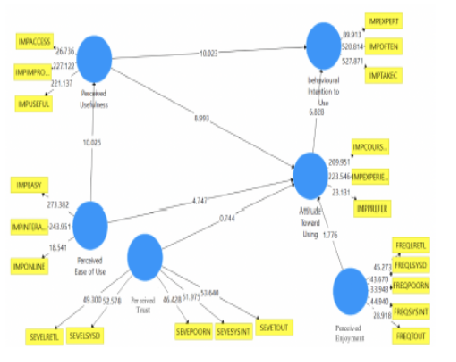


Indian Journal of Science and Technology
DOI: 10.17485/IJST/v16i14.2451
Year: 2023, Volume: 16, Issue: 14, Pages: 1069-1081
Original Article
Godfred Yaw Koi-Akrofi1*, David Aboagye-Darko2, Jones Nyame3, Ebenezer Gaisie4, Isaac Owusu Danquah5
1Senior Lecturer, Department of Information Technology Studies, University of Professional Studies, Accra, Ghana
2Lecturer, Department of Information Technology Studies, University of Professional Studies, Accra, Ghana
3Assistant Supervisor, Systems and Network, Ghanalink Network Services Limited, Accra, Ghana
4Senior ICT Assistant, Department of ICT Education, University of Education, Winneba, Ghana
5P.hD. Student in MIS, Faculty of Business and Accounting, Lincoln University College, Malaysia
*Corresponding Author
Email: [email protected]
Received Date:22 December 2022, Accepted Date:07 March 2023, Published Date:12 April 2023
Objectives: This study aimed to investigate the motivating variables that affect students’ attitudes toward using Learning Management Systems (LMS) during the Covid-19 pandemic and beyond by extending the Technology Acceptance Model (TAM) to include perceived enjoyment and perceived trustworthiness. Methods: Data were collected from 599 tertiary students from across five public universities in Ghana using online questionnaires to measure Perceived Usefulness (PU), Perceived Ease of Use (PEU), Attitude Towards Use (ATU), and Behavioural Intention (BI). The collected data were analyzed using PLS-SMART. Findings: The study’s findings suggest that perceived usefulness and perceived ease of use affect students’ attitudes toward LMS use (That is, PEU — > ATU [O = 0.227, t = 4.747, p = 0.000] and PU — > ATU [O = 0.430, t = 8.993, p = 0.000]), which affects students’ behavioural intention to use IT (That is, ATU — > BI [O = 0.314, t = 6.828, p = 0.000]). In addition, the most vital relationship was “perceived ease of use” as a predictor of “perceived usefulness” (That is, PEU — > PU [O = 0.440, t = 10.025, p = 0.000]). Furthermore, contrary to expectations, perceived enjoyment and perceived trustworthiness, also considered critical predictors, did not affect students’ attitudes toward LMS use (That is, PE — > ATU [O = 0.085, t = 1.776, p = 0.076] and PT — > ATU [O = 0.033, t = 0.744, p = 0.457]). Novelty: These findings provide valuable insights which can enhance education quality and students’ acceptance of LMS during mandated environments such as the COVID-19 pandemic. The framework of the study is an extension of the original TAM model, including new constructs, perceived enjoyment, and perceived trustworthiness.
Keywords: Covid19; TAM; User acceptance; Tertiary institutions; LMS; Perceived enjoyment; Perceived trustworthiness
© 2023 Koi-Akrofi et al. This is an open-access article distributed under the terms of the Creative Commons Attribution License, which permits unrestricted use, distribution, and reproduction in any medium, provided the original author and source are credited. Published By Indian Society for Education and Environment (iSee)
Subscribe now for latest articles and news.